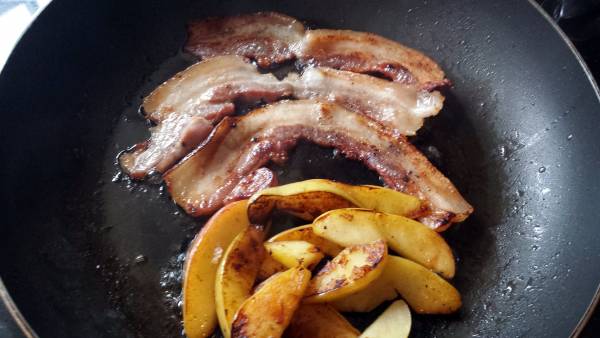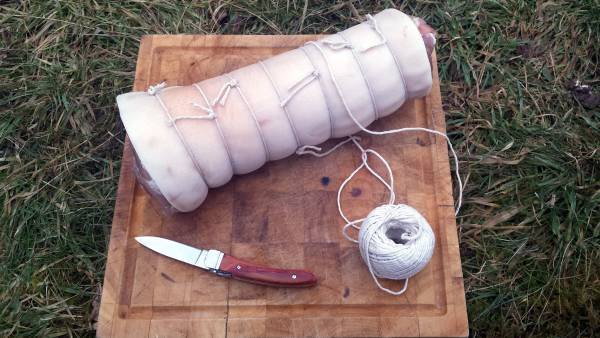Paleo and primal eating are huge in the world of sports and fitness now, with bacon being held as the divine ambrosia. This has inspired ranges of apparel extolling the virtues of the piggy treat and even poetry…sort of.
Roses are red
Violets are blue
I suck at poetry
Bacon
Paleo and primal eating are huge in the world of sports and fitness now, with bacon being held as the divine ambrosia. This has inspired ranges of apparel extolling the virtues of the piggy treat and even poetry…sort of.
Roses are red
Violets are blue
I suck at poetry
Bacon
But there is also the problem of nitrates and other chemicals, including celery salt. On top of that, the vast majority of bacons – even the fancy farm shop varieties – contain sugar in the cure, making it impossible to entirely eliminate sugar, if that is your aim.
What Is Curing?
The term “uncured bacon” is a baffling oxymoron. Uncured bacon is pork. I regard the salt as the main defining ingredient. In the best quality hams, like prosciutto di Parma and jamón ibérico, salt is the only ingredient other than pig. In fact, the Oxford English Dictionary defines the word cured as, “Preserved by salting, drying, etc.”
That definition also indicates what the process of curing is. The salt, by way of osmosis (as you may remember from high school chemistry) draws water out of the cells of both the meat and bacteria (the potentially hazardous and spoilage types). This kills bacteria and creates an environment that is no longer favorable for their growth.
“At its best, the seemingly dark art of home curing is applying the minimum amount of cure for the minimum amount of time to render the meat as safe as the process can, therefore yielding the most palatable end product.“
Preservation is the primary purpose of curing. It allowed people to store meat without it spoiling in the days before refrigeration. The curing process also concentrates the protein. Because there is less water, curing tenderizes tough tissue and, most importantly, enhances the flavor.
Once Upon a Time
I don’t actually believe this, nor can I remember where I heard it, but I am a born raconteur who will never miss the chance to tell a story. Apparently the ability to cure meat was one of the advances that allowed humans to go from nomadic tribes moving with the seasons to settled tribes with ready sources of food. Curing allowed them to go out and hunt but set up a permanent camp.
The story I originally heard went on to say this was also the reason vegetarians often regress to bacon. By the above rationale, our species thrived due to their love of the stuff. Hmm.

How to Do It
But I digress, so on with the show. At its best, the seemingly dark art of home curing is simply applying the minimum amount of cure for the minimum amount of time to render the meat as safe as the process can. Curing also yields the most palatable end product.
The simplest and most reliable way to achieve this goal is through what I would call a pancetta-style process. The exact quantities of salt and sugar and curing times are easily stipulated by measuring proportions:
- Amount of Salt/Sugar: Calculate five percent of the weight of the boned meat – that’s how much salt you will use. Cut the amount of salt in half, and that’s how much sugar you use.
- Curing Time: Cure the meat in the refrigerator for three days per 500g.
Then the meat is tied and left to dry. It can be eaten immediately, like bacon. If left to dry further, it will lose around thirty percent of its original weight in water and can be eaten as an air-dried ham. Exciting, eh? Or of course, you can smoke it.
The curing process is pretty simple, too. All you need is a sealable bag, big enough to lay the meat flat. You rub the cure into the meat, then put the meat and all of the cure into the bag. Refrigerate and turn daily. The salt will draw out water to form a brine, which will then cure the meat thoroughly.

Basic Cure: Herby Salt
First thing that I do is make the basic cure. The salt I use is PDV (Pure Dried Vacuum). This is pure salt that has been dried and sealed to keep it granular rather than using an anti-caking agent. Here’s how to do it:
- Put the salt into an airtight container with a fresh bunch each of thyme, rosemary, and bay leaves.
- Add a tablespoon each of black peppercorns and juniper berries.
- Seal it and give it a good shake. Then it is ready for when you need it.
You can then add an extra flavor appropriate to whatever meat you are using. I like fennel with pork and maybe mint with duck, but you can get creative here – or not. It will blow your socks off either way.
Recipe for a 1.7kg Pork Belly
So you get an idea of the whole process, here’s how I recently cured a 1.7kg pork belly.
- Make the cure. The piece of pork I had was 1.7kg, so I mixed 85g of my herby salt with 42g of soft brown sugar and a teaspoon of fennel seeds.
- Put the pork into a sealable bag. I got a vacuum pack bag from my butcher.
- Rub the cure on both sides of the belly and tip the rest in. Push as much air out as possible, then seal the bag. I used everyone’s favorite product – duct tape – to seal it.
- Refrigerate for 3 days per 500g. For my 1.7kg piece, I refrigerated it for 10 days, turning daily. You will see the brine forming from the water drawing out of the meat.
- After the correct number of days have passed, take the pork out of the bag and rinse it thoroughly. You can now roll and tie it. Look this up on the Internet, as it is very rewarding to tie a bacon properly. You could slice it and cook it straight away, but it is best left to dry somewhere cool. As I said, when it has lost 30% of the original weight it can be eaten as a charcuterie cut, i.e. raw. So go on and have a slice, but leave the rest because it is worth the wait.
To keep the numbers simple, try to work with round numbers. For example, a boned, rolled belly of pork weighing 2kg would need 100g of the salt mix and 50g of brown sugar.

It’s Not Just for Pork
This fun is not out of bounds for kosher eaters or anyone with aversion to swine, as the same process can be applied to a breast of lamb or even better mutton. In fact, just before Christmas an occasional customer of mine approached me with my favorite question of the year. Knowing I’m a foodie and a Scandi-phile he asked, “Have you ever tried salted mutton ribs?”
This was right up my alley: odd cuts of unpopular animals, cured – yum. A little bit of research led me to create what I would call lambchetta – that is, a cured breast of lamb or mutton. So I did it, but with a tiny floral tweak.
Ingredients:
- 1kg breast of mutton
- 50g herby salt
- 25g soft brown sugar
- 1 teaspoon dried lavender
Method:
- Mix the salt, sugar, and lavender together.
- Put the lamb in a bag, rub it with the cure on both sides, and tip in any remaining cure.
- Push out the air and seal the bag.
- Leave to cure in the fridge for 6 days.
- Take out of the bag and rinse thoroughly, then slice and fry in a dry pan. You could then cook a few tart berries in the pan to make a lovely cleansing sauce.
Do you cure your own meats? Share your experiences and favorite recipes in the comments below!
Further Reading for Bacon Lovers:
- 2 Easy Homemade Bacon Recipes
- Don’t Mess With My Bacon: The Truth About Nitrates
- Nitrates and Nitrites: Should We Stop Eating Bacon?
- What’s New On Breaking Muscle Today
Photo 2 courtesy of Shutterstock.






